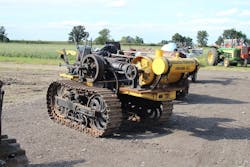Bullock Two-Cylinder Creeping Grip Tractor
There are rare tractors, and then there are those that are truly unique, as in one of a kind. The Bullock Creeping Grip Tractor in the National Construction Equipment Museum’s collection qualifies.
The tractor’s origins are subject to at least three different published versions, so we won’t get into that other than the following: The line originated with Western Implement and Motor Co. of Davenport, Iowa, and the first model was the Creeping Tiger halftrack. The line was acquired by Henry Bullock after Western’s failure in 1913, and he moved production to Chicago, where he already had an iron works.
Bullock wanted to design and build a tractor that was tough, simple, and economical, and the year he bought Western he had a prototype crawler tractor built. This prototype was all of that; the simplicity is visible in the manner in which the engine and parts of the powertrain were fully exposed for easy access. Even the radiator fan, which replaced a cooling tower, was wide open and unguarded.
Besides the tractor itself being one of a kind, it was also unique in being the only known crawler tractor to be powered by an opposed piston engine. The engine was a Heer 16 drawbar horsepower model, and could burn gas, distillate, or—with increased piston wear—kerosene. It ran at 900 rpm, producing a maximum speed of 2.5 mph. It also pioneered electric start, by means of dry cell batteries. A dynamo and, later, magnetos provided power once it was running.
It could turn on its own axis by setting the tracks in opposite directions. The two steering clutches were on opposite ends of the crankshaft and had to be shifted individually, with difficulty unless the tractor was under load. Travel speed was controlled by shifting between sprockets.
It was quite powerful, but the benefits came at a considerable cost for operation and maintenance. Oil ran right through it to the ground because it didn’t have a closed crankcase. Grease cups for the bearings had to be filled daily, and the crawlers and clutch needed annual repairs.
It was used for years on Bullock’s ranch in upper Michigan in all manner of agricultural and logging applications. When the ranch shut down, Bullock gave the tractor to the foreman, who used it to power a small sawmill. He in turn sold it to collector Lewis D. Good, and HCEA member Glenn Higgins acquired it at Good’s estate auction. He restored it and donated it to the National Construction Equipment Museum in 2013. It will be on display during the HCEA’s 2022 International Convention and Old Equipment Exhibition, to be held at the Museum September 16 to 18, 2022.
The Historical Construction Equipment Association (HCEA) is a 501(c)3 nonprofit organization dedicated to preserving the history of the construction, dredging, and surface mining equipment industries. With over 3,800 members in 25 countries, HCEA activities include publication of a quarterly educational magazine, Equipment Echoes, from which this article is adapted; operation of National Construction Equipment Museum and archives in Bowling Green, Ohio; and hosting an annual working exhibition of restored construction equipment. The next International Convention and Old Equipment Exhibition will be September 23 to 25, 2022, at the National Construction Equipment Museum in Bowling Green, Ohio. Individual annual memberships are $35 within the U.S. HCEA seeks to develop relationships in the equipment manufacturing industry, and offers a college scholarship for engineering and construction management students. Information is available at www.hcea.net, or by calling 419.352.5616, or emailing [email protected].
